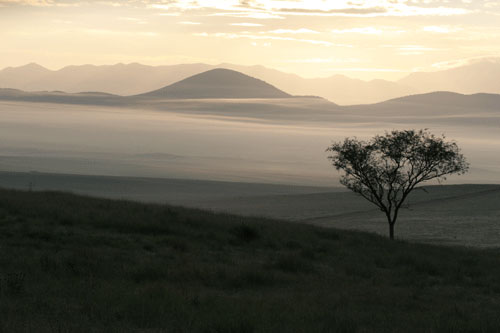
An early winter’s morning in the San Rafael grasslands Photo: Beth Russell
This short winter tour covers a slice of southeastern Arizona at a time when bird populations are high—in some cases spectacularly high. We’ll visit imposing mountains, desolate canyons, vast grasslands, desert lakes and streams, and a few favored human-made sites. We’ll look for the area’s specialized avifauna, search for rarities along our route, and talk about what we’re seeing.
Other than our bookend nights in Tucson, we’ll stay at the charming Casa de San Pedro, a beautiful place with perfect night skies and birds just outside the door.
Day 1: The tour begins this evening in Tucson. Night in Tucson.
Everything was perfect. Jake is a superb leader with tremendous birding skills as well as great people skills. The B&B was comfortable and charming, and the food ws fantastic. Even the birds put on a show, and Jake had us in a perfect place to watch.
MaryAnn Teal, Feb 2019
Day 2: We’ll depart to the south, stopping in Madera Canyon in the Santa Rita Mountains, where we’ll be met in the lower canyon’s oaks by Arizona Woodpecker, the gregarious Mexican Jay, Bridled Titmice, and perhaps a stunning Painted Redstart. We’ll pause in desert scrub along the way to look for Rufous-winged and tinkling Black-throated Sparrows, among other inhabitants. Continuing east through Box Canyon, we’ll emerge in rolling grasslands, where perhaps we’ll see Meadowlarks and Quail fleeing from roadside fences.
We’ll pass through Sonoita in the heart of Arizona’s wine country, where various sparrows and raptors exploit the vast open lands, and continue east toward the north-flowing San Pedro River and Casa de San Pedro, our very comfortable home for the next five nights and a superb place to come back to on a winter’s late afternoon. Night at Casa de San Pedro near Sierra Vista.
Days 3–6: From our base at Casa de San Pedro, we’ll fan out in all directions, letting weather and circumstances determine each day’s destination. In general we’ll work from the farthest spot west, in and around Patagonia, and continue a bit farther east every day until we end up in the celebrated Chiricahua Mountains.
We’ll visit Patagonia Lake State Park, where typical birds include Ash-throated, Gray, Hammond’s, and Dusky Flycatchers, and with luck an Elegant Trogon or Black-capped Gnatcatcher, species that have occurred here in very low numbers in recent years. We’ll also visit feeders in Patagonia proper, where a few striking Violet-crowned Hummingbirds often winter and Lazuli Buntings add electric blue to the color palette. The Patagonia city park with its large trees often ripe with fruit, can harbor interesting wintering species such as rare sapsuckers or Hepatic Tanager.
We’ll explore the Huachuca Mountains and the San Pedro River drainage. What we do here will depend to some extent on what we’ve seen during the tour’s first days. Several wonderful canyons on the eastern slopes of the Huachucas can hold tooting Northern Pygmy Owls or Montezuma Quail. The San Pedro River sometimes has a Green Kingfisher in residence, often detected by its softly penetrating call, like two stones tapped together.
We’ll spend a day in the Sulphur Springs Valley, where given reasonable water levels we’ll witness the mass arrival at Whitewater Draw of thousands of Sandhill Cranes from their morning’s foraging. At its best, it’s a spectacular, occasionally deafening experience as multitudes of birds return from feeding on waste corn and other crops in the valley. In addition to the cranes, Whitewater holds a mix of other waterbirds, often including a shimmering cloud of Snow and Ross’s Geese.
The primitive appeal of large birds in such high numbers is undeniable, but for some the real attraction of the Sulphur Springs Valley is the mass of sparrows, buntings, and raptors that are drawn to all the food that this well-watered valley provides. It’s never quite the same from one year to the next, but regal Ferruginous Hawks are common and Red-tailed Hawks in all their bewildering variation are abundant. If it’s a good seed year, waves of White-crowned and Brewer’s Sparrows pour over the landscape and the soft, whistled “whew” of Lark Buntings is everywhere. Among the less common denizens we may encounter are Mountain Plover, buffy-faced Bendire’s and streaky Sage Thrashers, or perhaps Thick-billed Longspur.
No trip to southeast Arizona would be complete without a visit to Portal at the mouth of Cave Creek Canyon in the heart of the mighty Chiricahua Mountains. Several types of habitats converge in this area and the bird diversity is reflective of this. In the big thicket just outside town we’ll look for the very shy Crissal Thrasher, the recently split Woodhouse’s Scrub-Jay, and spry Black-tailed Gnatcatcher. Portal proper has numerous feeder arrays and we’ll hope to see Rivoli’s Hummingbird and Blue-throated Mountain-gems, both distinct possibilities this time of year. If the road conditions allow us to head into the higher reaches of the mountain range we’ll have a chance to cross paths with Mexican Chickadee, this being the only place north of Mexico one can see this range-restricted species. Nights at Casa de San Pedro near Sierra Vista.
Day 7: After our last delicious breakfast at Casa de San Pedro, we’ll return to Tucson. This desert city is a magnet for wintering birds, usually including something rare. We’ll take time to visit parks and lakes scattered throughout the Tucson Valley, searching for stakeouts and resident species associated with the Sonoran Desert we may have missed. We’ll finish the day with an afternoon stroll around Tucson’s Sweetwater Wetlands, a wonderfully accessible collection of ponds and scrub that holds hundreds of ducks and wintering passerines. As the afternoon fades and dusk sets in, impressive numbers of blackbirds, including male Yellow-heads, come in to overnight in the reed beds. Night in Tucson.
Day 8: The tour concludes this morning in Tucson.
Updated: 15 March 2024
Prices
- 2025 Tour Price: : $3,250
- Single Occupancy Supplement: : $830
Notes

Questions? Tour Manager: Sara Pike. Call 1-866-547-9868 (US or Canada) or (01) 520-320-9868 or click here to email.
* Tour invoices paid by check carry a 4% discount. Details here.
Maximum group size seven with one leader.
